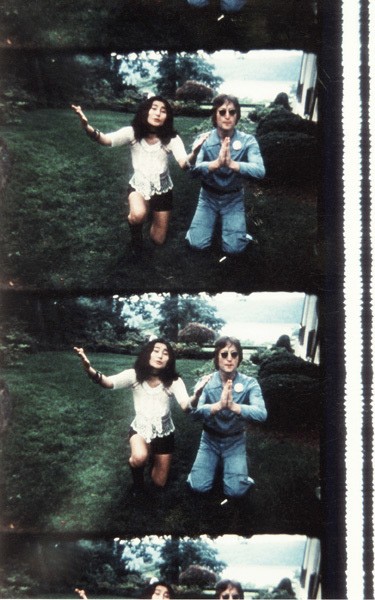
Jonas Mekas, Yoko Ono och John Lennon bönfaller George Maciunas att komma till deras fest genom att posera för en polaroidbild som ska leveras till honom. George var arg och kom inte, New York 1971 © Jonas Mekas
The 1st at Moderna: Jonas Mekas
Farewell to SoHo
1.3 2005 – 17.4 2005
Stockholm
Mekas’s extensive oeuvre includes celebrated films like Guns of the Free (1961), The Brig (1963), Walden (1969), Lost, Lost, Lost (1975), Reminiscences of a Journey to Lithuania (1972), Zefiro Torna (1992) and As I Was Moving Ahead, Occasionally I Saw Brief Glimpses of Beauty (2001) and stretches in time from the early fifties up to this very day.
Mekas has also been an important force in the development of American independent cinema. In 1954 he became editor-in-chief of Film Culture; in 1958 he began writing his Movie Journal column for Village Voice; in 1962 co-founded the Film-Makers’ Cooperative and in 1964 the Filmmakers’ Cinematheque, which grew into Anthology Film Archives, one of the world’s largest and most important repositories of avant-garde films.
Jonas Mekas’s films take us through important developments in American history without creating generalized and detached ‘objective’ stories. He lets us see the world from his perspective, which doesn’t intend to represent any official version of events. Instead he notices small things, and focuses interest on them. As he said in a public conversation at M.I.T. on 19 January 1971: ‘I’d almost say, the rule is, that the more subjective one is, the more objective one can attain. The deeper you go into yourself, the more you’ll touch the others, at some point. But if you begin to want to be very objective, to want everybody see the same you’re forced to stick to a certain defined level and you remain on the surface, and reveal really nothing of value to others’.
Jonas Mekas produces films of everyday life, witnessing everything around him and unobtrusively offering his own view about what he sees. Once in a while he looks back at the films and cuts them in different patterns that reveal new layers of the world. In the beginning, he says, he thought of what he was doing as tests preparing him for his ‘big film’. Only later did he realize that his footage was in itself an ongoing diary of his life in New York.
Keeping a written diary was always part of Jonas Mekas’s life. As a displaced person in Germany during and after the war he started writing down his observations. In his diaries, which have been translated into many languages, Mekas notes a variety of memorable or simply mundane moments, creating a distinct view of his life at the time. His writing have a lot in common with his later diary films: they take us from one moment of his life to another, sometimes keeping pauses, not forcing any straightforward connections between the moments, just letting us indulge in the life on the book pages as well and in film frames.
As Jonas Mekas noted in a recent interview I did with him in New York: when he films, he doesn’t really intend to follow through any particular visual narrative. He just snatches a moment he wants to memorise before all its magic disappears. It’s not easy to catch those glimpses, since sometimes they tend to escape attempts of being captured on film and change into something else when the camera starts rolling. When Mekas films, he may leave the camera off for some time or even not touch it for days, and then he will fill in the next frame with completely different visual information. He doesn’t follow predictably constructed patterns, but lets the magic of the accidental become visible and come across in all of his work.
The screening programme of the 1st at Moderna Museet gives us a few important cuts and insides from Jonas Mekas’s life and work. It represents his ideas about home, about life in New York; it takes us to meet his friends who often are legendary persons of the 20th century: John Lennon, George Maciunas, Yoko Ono and many others. All of the films are an important part of the history of American independent cinema.
The Farewell to SoHo video installation takes us through the changes that came across the SoHo neighbourhood in New York, which was brought to life in the seventies as an artists’ utopian colony started by the father of Fluxus George Maciunas. With the recent changes in the city most of the artists were pushed out of SoHo by new trendy enterprises. Jonas Mekas left quite recently. As he says, an artist utopia was overtaken by a business utopia. This work takes us through the visual memories of the place, projecting special atmospheres and inviting us to experience subjective lives there. It’s a diary of a place that has vanished and changed into something else.
Liutauras Psibilskis, Critic and curator
Credit: The Farewell to SoHo was an exhibition curated by James Fuentes at Gavin Brown’s Enterprise at Passerby in March 2004.
The 1st at Moderna is an exhibition programme for contemporary art. The opening is always on the first day of the month, and the exhibitions are in different venues in or outside the museum.
